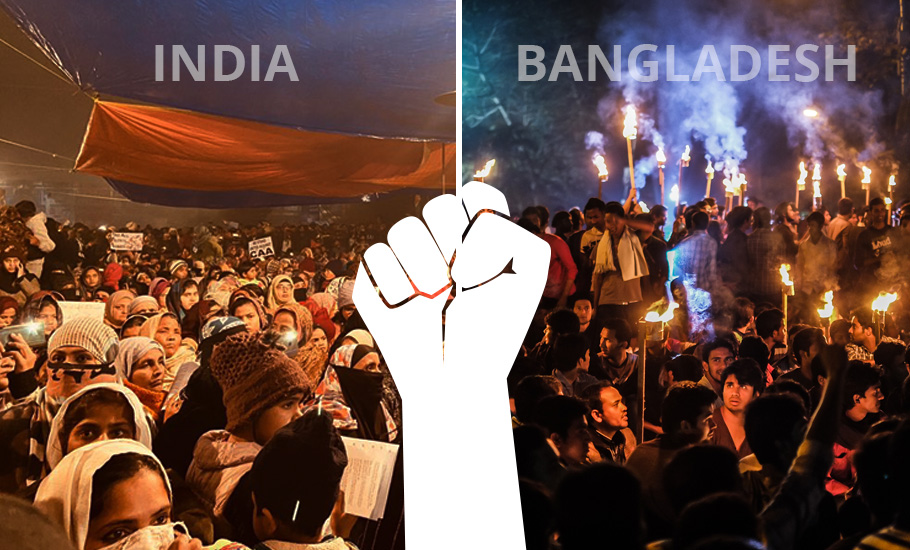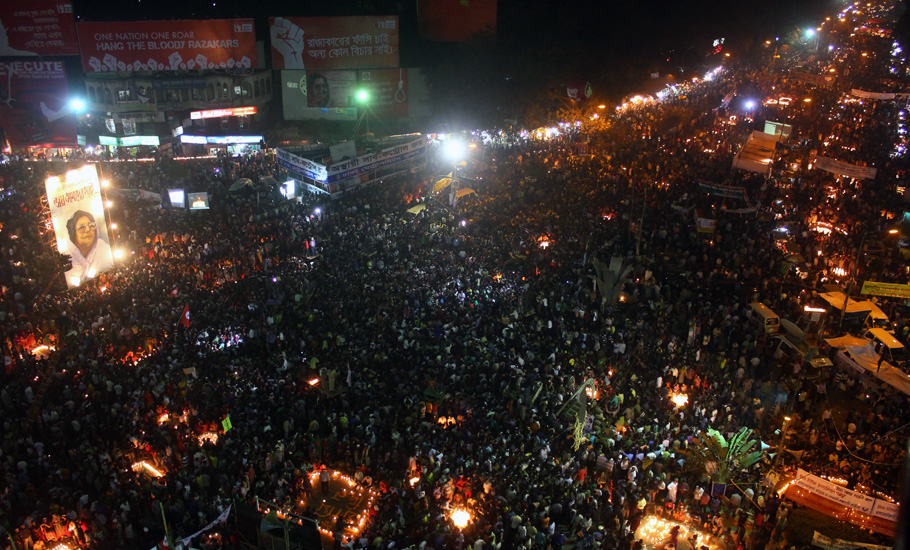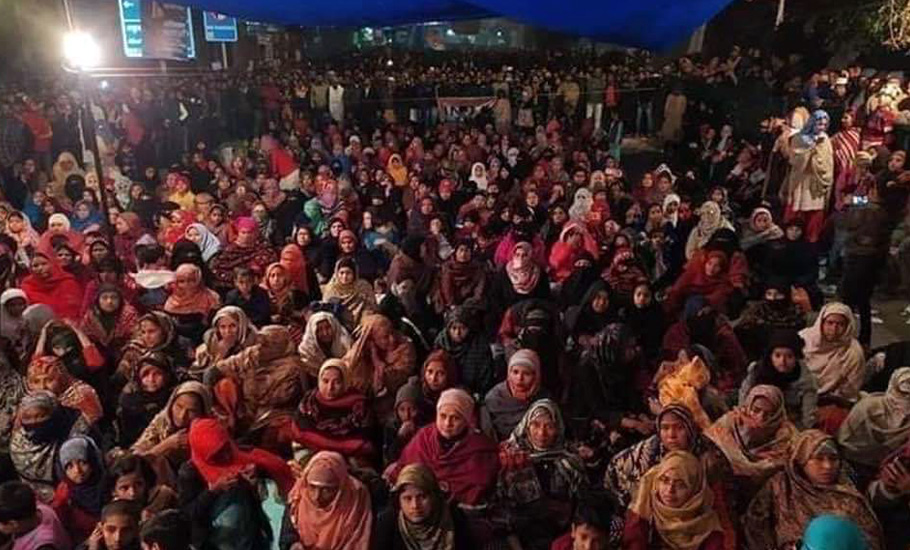
- Home
- News
- Analysis
- States
- Perspective
- Videos
- Education
- Entertainment
- Elections
- World Cup 2023
- Features
- Health
- Business
- Series
- Economy Series
- Earth Day
- Kashmir’s Frozen Turbulence
- India@75
- The legend of Ramjanmabhoomi
- Liberalisation@30
- How to tame a dragon
- Celebrating biodiversity
- Farm Matters
- 50 days of solitude
- Bringing Migrants Home
- Budget 2020
- Jharkhand Votes
- The Federal Investigates
- The Federal Impact
- Vanishing Sand
- Gandhi @ 150
- Andhra Today
- Field report
- Operation Gulmarg
- Pandemic @1 Mn in India
- The Federal Year-End
- The Zero Year
- Premium
- Science
- Brand studio
- Home
- NewsNews
- Analysis
- StatesStates
- PerspectivePerspective
- VideosVideos
- Entertainment
- ElectionsElections
- Sports
- Loading...
Sports - Features
- BusinessBusiness
- Premium
- Loading...
Premium

Shahbag to Shaheen Bagh: Anti-CAA protests have echoes of a secular movement in B'desh
The Shahbagh Spring definitely emboldened the minorities to come out and express their opinion. The Shaheen Bagh protest, much as Shahbagh, has also given voice to the minorities, but can they reclaim the lost space in Indian politics is something that the New Year will wait to see.

Thousands of people breaking into Jana Gana Mana and waving the national flag under an open night sky is perhaps the most heartening image of India’s ongoing mass protests against the contentious Citizenship (Amendment) Act. This picture of protest from Shaheen Bagh in Delhi might as well be that of Shahbag in Dhaka six years ago, but for the colour of the national flags and the rendition...
Thousands of people breaking into Jana Gana Mana and waving the national flag under an open night sky is perhaps the most heartening image of India’s ongoing mass protests against the contentious Citizenship (Amendment) Act. This picture of protest from Shaheen Bagh in Delhi might as well be that of Shahbag in Dhaka six years ago, but for the colour of the national flags and the rendition of two different compositions of Rabindranath Tagore.
The massive mass protests that have erupted across India over the citizenship law bear semblance to the secularist movement that started on February 5, 2013 in neighbouring Bangladesh.
Shahbag, a Dhaka neighbourhood that houses several premier educational institutions of that country, including the University of Dhaka, became the epicentre of the movement as protesters camped there for days much as dissenters have been camping in south Delhi’s Shaheen Bagh to protest against the Citizenship (Amendment) Act for over two weeks now.
In both the cases, youths and women were the forerunners of the agitation with social media playing a crucial role in mass mobilisation, leading to many intellectuals and celebrities joining the agitation and extending solidarity. But more than the mode of demonstrations, it’s the spirit of the two protests that has made them similar. In both the cases, people overwhelmingly hit the streets to uphold what they considered the founding principle of their respective countries. Hence, it’s imperative to draw some lessons from Bangladesh’s ‘Arab Spring’ moment in the context of the current uprising in India.
Shahbag movement
On that Tuesday morning of February 2013, Dhaka was tense ahead of a crucial verdict in a war crime case against top politician and Islamist leader Abdul Quader Mollah. But little did anybody guess that the verdict would trigger a mass movement.

Within half an hour of the International Crimes Tribunal (Bangladesh) giving life sentence to the Jamaat-e-Islami leader, thousands assembled in Shahbag, seeking capital punishment for the 65-year-old politician. Soon protests spread across the country with people, mostly youth, coming out in large numbers in various cities across the country demanding stringent punishment for religious fanatics who had committed “crimes against humanity” during Bangladesh’s Liberation War in 1971. They also sought the banning of the Bangladesh Jamaat-e-Islami party from politics and a boycott of institutions supporting the party or those affiliated to it. Incidentally, Jamaat was an ally of the Bangladesh Nationalist Party (BNP), a former ruling party of the country.
The goal of the protesters was to make Bangladesh a secular and a more inclusive nation, isolating the fanatics and reinstating the “spirit of the freedom movement”.
Several Hindus as well as Muslims were the victims of the war crimes perpetrated by the accused who had joined hands with the Pakistani army to suppress the Bengali nationalist movement in the erstwhile East Pakistan. The civil war that ensued forced hundreds of innocent people to flee to India, triggering a refugee crisis. Many Hindus stayed back in India even after East Pakistan attained freedom and became a sovereign country, Bangladesh. In a weird twist of history, those backing the contentious citizenship law in India today try to portray these refugees, among others, as victims of religious persecution, who needed protection under the new law. Those refugees had, in fact, fled ethnic cleansing, and not religious persecution.
Lessons from Shahbag
To defeat Bangladesh’s “secularist movement”, the right-wing Islamists launched a counter-protest, questioning the religious credentials of those harping on secularism — much like the pro-CAA rallies organised by the BJP and affiliate organisations. The extreme views that militant atheists among the Shahbag protesters had on Islam, to a certain extent, helped discredit the movement as anti-Islam. This gave rise to the radical advocacy group Hefazat-e-Islam in the country.
Many observers feel that the Shahbag protesters, who largely hailed from Bangladesh’s growing middle class, had failed to convey to common people that secularism is not antithesis to Islam but is in sync with Islamic tenets of equality and universal brotherhood.
Taking a cue from Bangladesh, some feel, protesters in India should also be extremely cautious about any move to depict their movement as anti-Hindu.

Positive lessons
Despite failing to ensure a larger change in Bangladesh, the Shahbag movement had many positives.
“It’s true that radical forces such as Hefazat-e-Islam got a shot in the arm following the Shahbag movement as many viewed the nationwide protests as anti-Islam. But the movement did succeed in politically isolating Jamaat and made secularism once again relevant in Bangladesh’s politics,” said Gazi Nasiruddin Ahmed, joint editor of Dhaka-based Bengali daily Desh Rupantor.
Ahmed said the movement had fizzled out as it was spontaneous and not organised, just as the Arab Spring remained a bubble.
There was no effective leadership to take the movement to its logical conclusion after its initial demand for “highest punishment” to the war criminals was addressed, he said.
Leadership is also an issue with the ongoing protests in India. There are already signs of the protests losing some steam after the Union government’s U-turn on nationwide National Register of Citizens (NRC).
Minority regained voice
Though secularism was one of the four bedrocks of Bangladesh’s Constitution adopted in 1972, it was removed in 1977 by the fifth amendment by BNP founder and de facto military ruler General Ziaur Rahman. Further, Islam was declared the state religion in 1988, during the military regime of Muhammad Ershad, severely shrinking the minority space in Bangladesh.
Also read | Shaheen Bagh body calls off protest, but locals continue sit-in
In 2010, the Bangladesh Supreme Court, however, restored secularism declaring the fifth amendment of the Constitution illegal.
But it was the Shahbag movement, where secularists from the majority community fought for the rights of the minorities, gave the marginalised their voice as equal stakeholders of the nation, observed Biswadip Das, special affairs editor of the bdnews24.com, a Dhaka-based news portal.
He said the movement definitely emboldened the minorities to come out and express their opinion and that, to him, was the biggest takeaway of the Shahbag Spring.
The Shaheen Bagh protest, much as Shahbag, has also given voice to the minorities. But can they reclaim the lost space in Indian politics? This is something the New Year will reveal.

